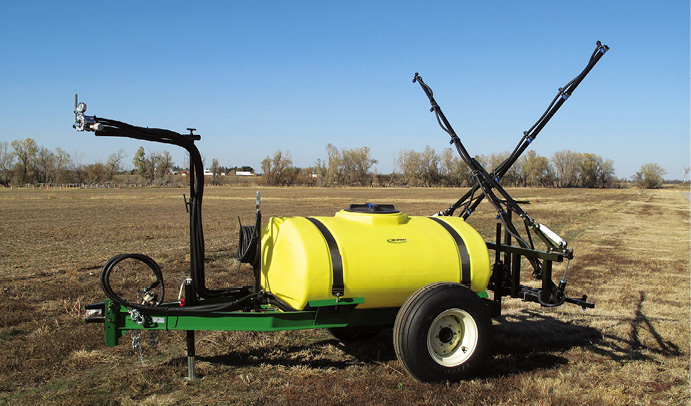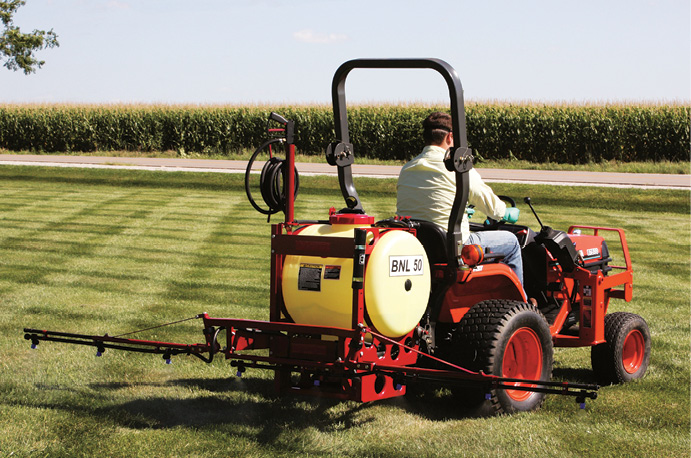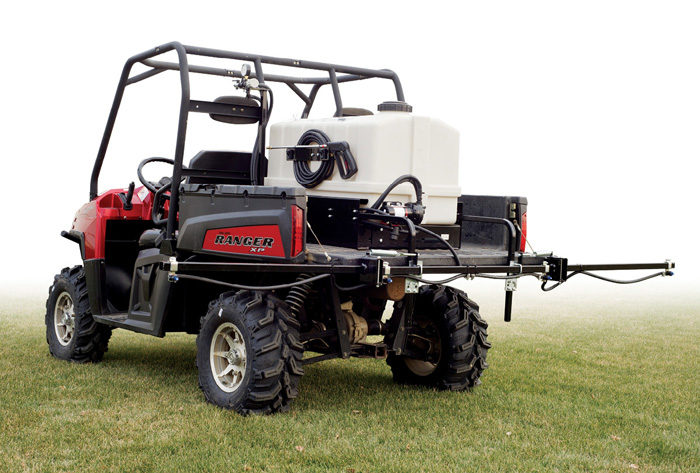Homeowners are candidates for 12-volt powered skid-mounted sprayers that can be put in the back of a pickup truck, 4-wheeler or utility vehicle like this Demco ProSeries model being hauled in a Polaris Ranger.
It may seem odd to discuss how to sell a product for which the selling season has ended. However, if you want to enter the sprayer business or if you’d like to step up your efforts, the time to start is now by ordering product for the 2016 season. Sprayers sell when weeds grow and most customers won’t wait for an order to be placed when purchasing. They want to take them home and put them to use.
Randal Bobbitt is a site manager for P&K Equipment, a 10-store John Deere dealership in Oklahoma, and handles ordering the Ag Spray brand of sprayers for all locations. He says there are 3 distinct categories of sprayers sold in his area, “The first is a ‘skid’ model, which goes in the back of a 4-wheeler and is powered by the 12-volt battery. Second are three-point sprayers, which mount on compact and utility tractors and run 55-200 gallons. Finally, there are trailer sprayers, which run 300-500 gallons and are towed by a tractor.”
The skid sprayers sell the most units because nearly all of a dealership’s regular customers are prospects. “Even your full-time farmers want something to throw in the back of a Gator and spray fence lines or spot spray, people in town want to spray around the yard, and there’s everyone in between. They don’t necessarily need an ATV to make it work. Many times, they’ll put it in the back of a pickup truck and hang the handgun out the window and spray fencerows.”
Customers who purchase three-point sprayers are usually large property owners. “They usually own from a 25-75 horsepower tractor and may spray pasture and roadsides. A lot of them are built without booms, just a nozzle that fans out the spray from 18-30 feet, depending on the model,” Bobbitt says.
The largest sprayers are generally for agricultural use. “The 300-500 gallon models generally go to cattle people who want to improve their pastures or hayfields by eliminating weeds. Most of them are also boomless, although 20-25% are purchased with a foldable boom,” he says.
Bobbitt points out that dealers must offer service to be successful selling to sprayer customers. “The main thing they’re concerned about is when they have a problem, they want to get it fixed,” he says. And, having the inventory on hand when the season hits is just as important. “You can’t just have one of each sprayer in stock, because once you start selling, you may have 4 identical models and sell them all in 3 days. Ordering in the season doesn’t work, you won’t get it,” Bobbitt says.
The number of units needed to support sales may surprise prospective dealers. Bobbitt advises, “If you’ve never been in that business you should probably plan to sell and stock around 15-25 of the 40- and 60-gallon skid sprayers. They seldom have any kind of boom and are mostly sold with just a handgun. There’s another little sprayer that’s popular and that’s the pull-behind 25-, 40- and 60-gallon models. Those are tougher to order. They’re offered boomless or with a little 7-nozzle folding boom, which most homeowners need to better control the spray. Our 10 stores usually only sell about 6-8 of those a year, so they’re not big movers, but starting out you’d want a couple because they’re impulse items and you have to stock them to sell them.
“Fifty-five gallon sprayers are popular for the compact tractor owners. The 110-, 150- and 200-gallon sizes don’t sell as many numbers. At an average-sized store, plan to stock two or three of the 55-gallon models and at least one each of the 110- and 150-gallon models. I’d possibly stay away from the 200-gallon model,” Bobbitt says.
“If you’re in cattle and hay country, the 300- and 500-gallon trailer sprayers will be popular. You sure want to start your year with at least three 300-gallon sprayers and three or four of the 500-gallon models,” he says.
“Sprayers are easily promoted with a large, visible display…”
Selling Premium Products
P&K has a long history in the sprayer business and they know how not to limit potential sales. For instance, when specifying sprayers, the dealership orders dual agitation when possible. This means the chemicals will be mixed more thoroughly and perform better. They also order the premium chemical-resistant pumps in case customers don’t immediately flush the chemicals after using, as well as deluxe handguns. Bobbitt says they’ll never offer the cheapest products and are willing to spend the time educating customers that not all sprayers are the same.
Ordering for the Ag Spray products is due in the fall for the following year. They have a $5,000 minimum pre-season order program, but Bobbitt says if you plan to be big in the business, you’ll have no problem coming up with an order that size. Promoting the product then becomes easy. “We don’t do a whole lot when it comes to advertising them. Our main objective in promoting sprayers is to position them right on the lot, so when people are coming in and out they see what we have. Since it’s an impulse buy, we want everyone who comes in the door to either drive by or walk by the display. A lot of your success will be strictly determined by how you display the product,” Bobbitt says.
The sprayer business fits nicely with the dealership’s product mix. “It gives our customers the opportunity to keep coming back to us. Does a sprayer lead to a tractor sale? Definitely. Does it enhance sales of what we’re already selling? It sure does, that’s the big thing,” he says.
Education Moves Product

|
|
Pull-type sprayers are popular among large acreage owners and cattle producers. Some feature both folding booms and boomless nozzles, like this 500-gallon pasture sprayer from Ag Spray. Photo Courtesy of Ag Spray |
Jerry Hoover, owner of Hoover Tractor in Mifflinburg, Pa., has been selling Hardi Sprayers for almost 15 years. The dealership also carries Kioti tractors, Pequea hay equipment and Sure-Trac trailers. He originally got into the business because customers were asking for parts for existing machines in the field. After the dealership requested a parts-only contract, Hardi insisted that they take on the full line and they’ve grown to be one of the bigger sprayer dealers in the northeast. Hoover says his market is diverse. “In the rural lifestyle area, we sell a lot of the 50-155 gallon, three-point hitch units. The 500-gallon pull-type is probably our ‘bread and butter.’ It’s a $15,000-$20,000 unit generally bought by 100-200 acre dairy farms. The larger commercial farms may purchase a self-propelled unit,” Hoover says.
He attributes stocking inventory to back up the retail demand as part of the success in selling the product line. Taking advantage of ordering programs can yield free freight on many products. “That makes a world of difference. If we had to pay freight on a 50-gallon sprayer that could add $100 or $200. Just like on any other small implement, freight is one of the largest issues we deal with,” he says.
Hoover does have support if he doesn’t have the exact inventory needed. “That’s where a good rep comes into play. He knows what’s out there in the territory and sometimes he can transfer it. We have great support from the manufacturer,” he says.
Success in the sprayer business also comes through helping customers get comfortable with the product. “The customer looks to you for knowledge on what nozzles to use and expects you to have parts in stock to make repairs. It’s just like any other product that you’re selling, product knowledge is a big deal. The biggest obstacle to selling the product is that some customers have a fear of applying chemicals,” he says.

|
|
It’s important to guide a rural lifestyle customer to a sprayer that fits the three-point lift capacity of their tractor. Avoid those stressful situations where new customers call because their tractor won’t lift their sprayer, which is loaded with pesticide. Shown is the Hardi BNL50 model being pulled by a Kubota compact tractor. Photo Courtesy of Hardi |
Hoover faces competition from cheaper manufacturers, but fights that by telling customers that Hardi designs and builds its pumps, tanks and nozzles and they’re all engineered to work together. “The smaller, low-cost competitors will buy tanks, fittings and other components from whoever has the best price and put them together. They’re not built to any certain spec.”
One of Hoover Tractor’s best promotions is an annual event at the dealership. “We empty out the service department and dedicate a day to holding a sprayer clinic. We have a local chemical company that also does part of it, so we educate the customer both about the chemical and its application. Applicators also need ‘core’ and ‘category’ points to maintain their Pennsylvania applicator license and the meeting counts toward that,” he says.
While the meetings must be devoted to training and not selling, Hoover says that a large percentage of sprayer buyers who have attended the clinics are now customers.
Sprayer sales in the northeast are on the upswing, especially for the smaller models used by those who are part of the “local food” trend. “In this area, we have a push to ‘buy local,’ which has prompted a lot of 2-acre vegetable farms with roadside stands. That has opened doors to small sprayer sales, which continue to be on the uptick,” Hoover says.
Matching the Need
Travis Routh, general manager of L&D Ag Services in Hartland, Minn., finds that selling sprayers is easy for him because his first job after college was as an agronomist selling fertilizer and chemicals. He has knowledge about mixing and applying farm chemicals, which made it easier to begin selling Demco, Top Air and Ag Spray sprayers at a dealership. “We sell anything from a 14-gallon ATV sprayer to large pull-types,” Routh says. The dealership also carries Unverferth, Ag Leader, Trimble and Raven, and manufactures liquid fertilizer equipment for all brands of planters.
The small units are generally sold to homeowners and the larger sprayers to lawn maintenance companies and farmers. “Effectively selling sprayers involves a lot of information exchange. The most important thing is that you need to listen to the customer and then ask enough questions to find out what they are looking for. If you don’t, it would be easy to sell something that’s not right for them. Some of the simpler things involve the equipment for pulling the sprayer, such as if it’s going to be tractor-mounted or tractor-drawn. You have to know what they have for a tractor and what its capabilities are, for example, hydraulic output and lifting capacity. You also need to know about the terrain and the size of planter. You have to do a fair amount of fact finding and ask a lot of questions,” Routh says.
Many of the folks purchasing the smaller sprayers are new, not only to that product, but also to tractors and other equipment.
Dealer Takeaways
|
There’s a possibility they can purchase too big of a sprayer for too little of a tractor. “That’s definitely something you really need to watch. They don’t know exactly what they can carry and you have to guide them. We handle different levels, so we have economy and deluxe versions of most sprayers.
“I try to figure out what the customer is looking for and guide him in that direction. If it’s a pull-type sprayer, the tire size is going to be a big deal, as well as the tank size, and the ‘fit and finish’ matters to most people,” he says.
Some of the larger sprayers offer many options that Routh tries to explain in detail to the customer. “Hand-wash tanks, boom leveling, chemical injection, rate control and the boom are probably the most important parts of the sprayer. We look at the quality of the boom, the options it has, how it folds and the reliability of everything. The other thing I always stress is that most of these sprayers have common, off-the-shelf parts. So if the customer needs something, we generally have it here in the store,” he says.
Most of the promotion for sprayers at L&D comes from word-of-mouth referrals and a reputation for backing up the product. “We’re known as a spray business. We have a display that’s right on a state highway outside of town, so that helps as well.”
Routh cautions that anyone wanting to sell sprayers should research the market first. “I’d take a look around your area and see how much competition or how many other dealers are around. If there are a lot of other people selling sprayers, it’s going to be tough, unless you have a niche or specialty. Also, look at what crops are grown and what uses there are for sprayers.”
Successfully selling anything involves having product knowledge, inventory and support after the sale. It’s probably even more so with sprayers, a product whose options, calibration and operation remain a mystery to many prospects.
The seasonality of the product demands stocking nearly a year’s supply prior to the start of weeds growing and risking carryover if a weather event should inhibit sales.
The good news is that sprayers are easily promoted with a large, visible display targeting all customers when they’re at your store and when they’re ready to buy, you’ll likely get their business.






Post a comment
Report Abusive Comment